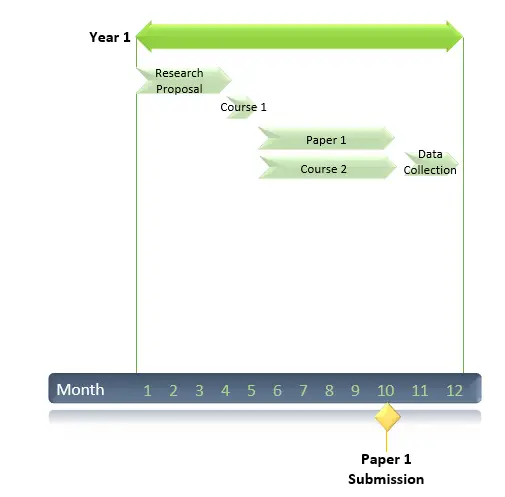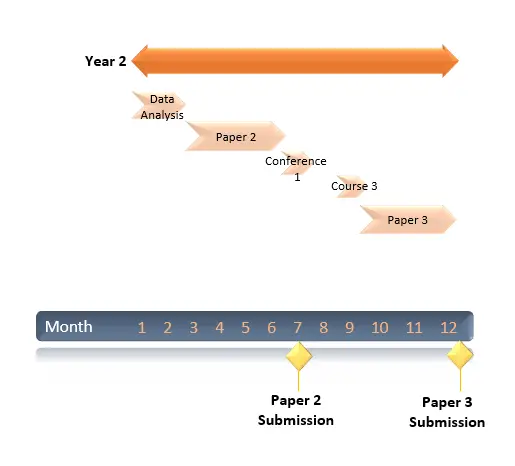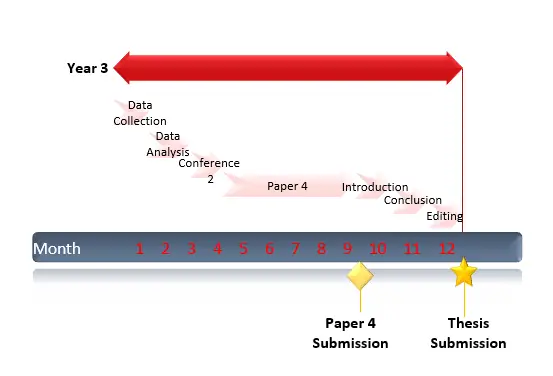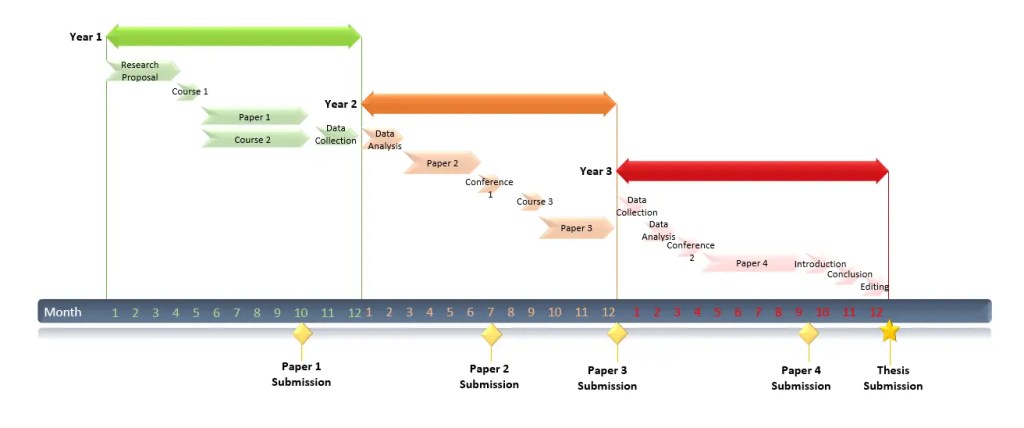

How to Prepare a PhD Research Plan/Schedule?
PhD research plan is a structured schedule for completing different objectives and milestones during a given timeframe. Scholars are usually unaware of it. Let us find out how to prepare it.
Between March 2021 to 2022, I read almost 15 different research proposals from students (for their projects) and only a single one, I found, with a comprehensive research plan for 3 years. Which is still not, kind of practical, probably copied from other students.
Such entities are not known to over 90% of students, if some know that because their university asked for but unfortunately, this basic procedure lacks penetration among students. I don’t know the exact reason, but students lack a basic understanding of the research process.
Meaning, that they don’t know or perhaps don’t complete their course work needly. PhD research requires many documents, SOPs and write-ups, before even starting it. For example, a rough research plan, research proposal, initial interview, competence screening, grant proposal and so on.
However, the requirement varies among universities and thus knowledge regarding basic procedures often also varies among students. So I’m not blaming students but certainly, it is the fault of the university side, as well.
When you come up with a research proposal with a research schedule or entire plant, certainly it will create a positive image and good reputation. So it is important. But how to prepare it?
Hey, there I’m Dr Tushar, a PhD tutor and coach. In this article, we will understand how we can prepare a structured plan for the PhD research and how to execute it.
So let’s get started.
How to prepare a PhD research plan/schedule?
A PhD research plan or schedule can be prepared using the GANTT chart which includes a month, semester or year-wise planning of the entire PhD research work.
First, enlist goals and objectives.
It’s not about your research objective enlisted in your proposal. I’m talking about the objectives of your PhD. Take a look at some of the objectives.
Note that these are all the objectives that should be completed during the PhD, but not limited to a specific subject. Note you have to show how you can complete or achieve each objective during the entire tenure of your work.
And that is what the plan/schedule is all about. Next, explain the time duration. The time required to complete each goal, roughly. For example, a semester or a year to complete the course work or 4 to 8 months for completion of ethical approval.
Now two things must be known to you, at this point in time.
- First, enlist the time required to complete each objective, as aforementioned.
- Second, what goals would you complete during each semester?
For instance, course work takes a semester to complete, but during the period a scholar can also craft their PhD research title, research proposal, ethical approval and grant proposals.
Now it is also crucial to know that there is no time bound to complete goals, but it should be completed as you explained. Let’s say you can plant it for 3 years, 4 or even 5 years depending on the weightage of your work.
In summary, the answer to the question of how to prepare a research plan is,
- Enlist your goals or objectives.
- Decide the time required to complete each goal.
- Prepare a GANTT chart.
Now you have prepared zero-date planning for your research but how to present it? The answer is a GANTT chart.
GANTT chart for PhD research plan:
GANTT chart is a task manager and graphical presentation of how and how many tasks are completed or should be completed against a given time duration. Take a look at the image below.
How can you prepare one?
Open MS Excel (on Windows) or numbers (on Mac).
Enlist goals or objectives in a column.
Enlist years (duration of PhD) in a row and bifurcate them into individual semesters. You can also prepare a month-wise plan, that’s totally up to you. In my opinion, semester-wise planning is good because research is a lengthy and time-consuming process. So monthly planning would not work.
To make a chart more attractive and readable use colors, as I used. Now mark a ‘cell’ against a column and row showing the objective which you are going to complete in a semester. Take a look.
After the end of this, your GANTT chart would look like this.
You can prepare a month-wise planning, individual semester-wise planning and goal-wise planning etc. I will explain these things in upcoming articles on 5 different types of GANTT charts for PhD.
Custom writing services:
If you find difficulties in preparing a research plan, synopsis, proposal or GANTT chart. We can work on behalf of you. Our costume services are,
- Synopsis writing
- Project writing
- Research proposal writing
- Research planning and GANTT chart preparation.
You can contact us at [email protected] or [email protected] to get more information.
Wrapping up:
Planning and executing a research schedule are two different things. Oftentimes, students just prepare as per the requirements and then do work as per their convenience. Then they are stuck in one place and just work around the time.
Plan things. Make your own GANTT chart, put it on your work table or stick it on a wall so that you can see it daily. Try to achieve each goal in time. Trust me things will work and you will complete your PhD before anyone else.

Dr. Tushar Chauhan is a Scientist, Blogger and Scientific-writer. He has completed PhD in Genetics. Dr. Chauhan is a PhD coach and tutor.
Share this:

- Share on Facebook
- Share on Twitter
- Share on Pinterest
- Share on Linkedin
- Share via Email
About The Author

Dr Tushar Chauhan
Related posts.

Why is it called a Doctor of Philosophy?

Preparing for a PhD Viva
Leave a comment cancel reply.
Your email address will not be published. Required fields are marked *
Save my name, email, and website in this browser for the next time I comment.
Notify me of follow-up comments by email.
Notify me of new posts by email.
How to write a research proposal
What is a research proposal.
A research proposal should present your idea or question and expected outcomes with clarity and definition – the what.
It should also make a case for why your question is significant and what value it will bring to your discipline – the why.
What it shouldn't do is answer the question – that's what your research will do.
Why is it important?
Research proposals are significant because Another reason why it formally outlines your intended research. Which means you need to provide details on how you will go about your research, including:
- your approach and methodology
- timeline and feasibility
- all other considerations needed to progress your research, such as resources.
Think of it as a tool that will help you clarify your idea and make conducting your research easier.
How long should it be?
Usually no more than 2000 words, but check the requirements of your degree, and your supervisor or research coordinator.
Presenting your idea clearly and concisely demonstrates that you can write this way – an attribute of a potential research candidate that is valued by assessors.
What should it include?
Project title.
Your title should clearly indicate what your proposed research is about.
Research supervisor
State the name, department and faculty or school of the academic who has agreed to supervise you. Rest assured, your research supervisor will work with you to refine your research proposal ahead of submission to ensure it meets the needs of your discipline.
Proposed mode of research
Describe your proposed mode of research. Which may be closely linked to your discipline, and is where you will describe the style or format of your research, e.g. data, field research, composition, written work, social performance and mixed media etc.
This is not required for research in the sciences, but your research supervisor will be able to guide you on discipline-specific requirements.
Aims and objectives
What are you trying to achieve with your research? What is the purpose? This section should reference why you're applying for a research degree. Are you addressing a gap in the current research? Do you want to look at a theory more closely and test it out? Is there something you're trying to prove or disprove? To help you clarify this, think about the potential outcome of your research if you were successful – that is your aim. Make sure that this is a focused statement.
Your objectives will be your aim broken down – the steps to achieving the intended outcome. They are the smaller proof points that will underpin your research's purpose. Be logical in the order of how you present these so that each succeeds the previous, i.e. if you need to achieve 'a' before 'b' before 'c', then make sure you order your objectives a, b, c.
A concise summary of what your research is about. It outlines the key aspects of what you will investigate as well as the expected outcomes. It briefly covers the what, why and how of your research.
A good way to evaluate if you have written a strong synopsis, is to get somebody to read it without reading the rest of your research proposal. Would they know what your research is about?
Now that you have your question clarified, it is time to explain the why. Here, you need to demonstrate an understanding of the current research climate in your area of interest.
Providing context around your research topic through a literature review will show the assessor that you understand current dialogue around your research, and what is published.
Demonstrate you have a strong understanding of the key topics, significant studies and notable researchers in your area of research and how these have contributed to the current landscape.
Expected research contribution
In this section, you should consider the following:
- Why is your research question or hypothesis worth asking?
- How is the current research lacking or falling short?
- What impact will your research have on the discipline?
- Will you be extending an area of knowledge, applying it to new contexts, solving a problem, testing a theory, or challenging an existing one?
- Establish why your research is important by convincing your audience there is a gap.
- What will be the outcome of your research contribution?
- Demonstrate both your current level of knowledge and how the pursuit of your question or hypothesis will create a new understanding and generate new information.
- Show how your research is innovative and original.
Draw links between your research and the faculty or school you are applying at, and explain why you have chosen your supervisor, and what research have they or their school done to reinforce and support your own work. Cite these reasons to demonstrate how your research will benefit and contribute to the current body of knowledge.
Proposed methodology
Provide an overview of the methodology and techniques you will use to conduct your research. Cover what materials and equipment you will use, what theoretical frameworks will you draw on, and how will you collect data.
Highlight why you have chosen this particular methodology, but also why others may not have been as suitable. You need to demonstrate that you have put thought into your approach and why it's the most appropriate way to carry out your research.
It should also highlight potential limitations you anticipate, feasibility within time and other constraints, ethical considerations and how you will address these, as well as general resources.
A work plan is a critical component of your research proposal because it indicates the feasibility of completion within the timeframe and supports you in achieving your objectives throughout your degree.
Consider the milestones you aim to achieve at each stage of your research. A PhD or master's degree by research can take two to four years of full-time study to complete. It might be helpful to offer year one in detail and the following years in broader terms. Ultimately you have to show that your research is likely to be both original and finished – and that you understand the time involved.
Provide details of the resources you will need to carry out your research project. Consider equipment, fieldwork expenses, travel and a proposed budget, to indicate how realistic your research proposal is in terms of financial requirements and whether any adjustments are needed.
Bibliography
Provide a list of references that you've made throughout your research proposal.
Apply for postgraduate study
New hdr curriculum, find a supervisor.
Search by keyword, topic, location, or supervisor name
- 1800 SYD UNI ( 1800 793 864 )
- or +61 2 8627 1444
- Open 9am to 5pm, Monday to Friday
- Student Centre Level 3 Jane Foss Russell Building Darlington Campus
Scholarships
Find the right scholarship for you
Research areas
Our research covers the spectrum – from linguistics to nanoscience
Our breadth of expertise across our faculties and schools is supported by deep disciplinary knowledge. We have significant capability in more than 20 major areas of research.
Research facilities
High-impact research through state-of-the-art infrastructure

How to Write a PhD Research Proposal
- Applying to a PhD
- A research proposal summarises your intended research.
- Your research proposal is used to confirm you understand the topic, and that the university has the expertise to support your study.
- The length of a research proposal varies. It is usually specified by either the programme requirements or the supervisor upon request. 1500 to 3500 words is common.
- The typical research proposal structure consists of: Title, Abstract, Background and Rationale, Research Aims and Objectives, Research Design and Methodology, Timetable, and a Bibliography.
What is a Research Proposal?
A research proposal is a supporting document that may be required when applying to a research degree. It summarises your intended research by outlining what your research questions are, why they’re important to your field and what knowledge gaps surround your topic. It also outlines your research in terms of your aims, methods and proposed timetable .
What Is It Used for and Why Is It Important?
A research proposal will be used to:
- Confirm whether you understand the topic and can communicate complex ideas.
- Confirm whether the university has adequate expertise to support you in your research topic.
- Apply for funding or research grants to external bodies.
How Long Should a PhD Research Proposal Be?
Some universities will specify a word count all students will need to adhere to. You will typically find these in the description of the PhD listing. If they haven’t stated a word count limit, you should contact the potential supervisor to clarify whether there are any requirements. If not, aim for 1500 to 3500 words (3 to 7 pages).
Your title should indicate clearly what your research question is. It needs to be simple and to the point; if the reader needs to read further into your proposal to understand your question, your working title isn’t clear enough.
Directly below your title, state the topic your research question relates to. Whether you include this information at the top of your proposal or insert a dedicated title page is your choice and will come down to personal preference.
2. Abstract
If your research proposal is over 2000 words, consider providing an abstract. Your abstract should summarise your question, why it’s important to your field and how you intend to answer it; in other words, explain your research context.
Only include crucial information in this section – 250 words should be sufficient to get across your main points.
3. Background & Rationale
First, specify which subject area your research problem falls in. This will help set the context of your study and will help the reader anticipate the direction of your proposed research.
Following this, include a literature review . A literature review summarises the existing knowledge which surrounds your research topic. This should include a discussion of the theories, models and bodies of text which directly relate to your research problem. As well as discussing the information available, discuss those which aren’t. In other words, identify what the current gaps in knowledge are and discuss how this will influence your research. Your aim here is to convince the potential supervisor and funding providers of why your intended research is worth investing time and money into.
Last, discuss the key debates and developments currently at the centre of your research area.
4. Research Aims & Objectives
Identify the aims and objectives of your research. The aims are the problems your project intends to solve; the objectives are the measurable steps and outcomes required to achieve the aim.
In outlining your aims and objectives, you will need to explain why your proposed research is worth exploring. Consider these aspects:
- Will your research solve a problem?
- Will your research address a current gap in knowledge?
- Will your research have any social or practical benefits?
If you fail to address the above questions, it’s unlikely they will accept your proposal – all PhD research projects must show originality and value to be considered.
5. Research Design and Methodology
The following structure is recommended when discussing your research design:
- Sample/Population – Discuss your sample size, target populations, specimen types etc.
- Methods – What research methods have you considered, how did you evaluate them and how did you decide on your chosen one?
- Data Collection – How are you going to collect and validate your data? Are there any limitations?
- Data Analysis – How are you going to interpret your results and obtain a meaningful conclusion from them?
- Ethical Considerations – Are there any potential implications associated with your research approach? This could either be to research participants or to your field as a whole on the outcome of your findings (i.e. if you’re researching a particularly controversial area). How are you going to monitor for these implications and what types of preventive steps will you need to put into place?
6. Timetable

We’ve outlined the various stages of a PhD and the approximate duration of a PhD programme which you can refer to when designing your own research study.
7. Bibliography
Plagiarism is taken seriously across all academic levels, but even more so for doctorates. Therefore, ensure you reference the existing literature you have used in writing your PhD proposal. Besides this, try to adopt the same referencing style as the University you’re applying to uses. You can easily find this information in the PhD Thesis formatting guidelines published on the University’s website.
Finding a PhD has never been this easy – search for a PhD by keyword, location or academic area of interest.
Questions & Answers
Here are answers to some of the most common questions we’re asked about the Research Proposal:
Can You Change a Research Proposal?
Yes, your PhD research proposal outlines the start of your project only. It’s well accepted that the direction of your research will develop with time, therefore, you can revise it at later dates.
Can the Potential Supervisor Review My Draft Proposal?
Whether the potential supervisor will review your draft will depend on the individual. However, it is highly advisable that you at least attempt to discuss your draft with them. Even if they can’t review it, they may provide you with useful information regarding their department’s expertise which could help shape your PhD proposal. For example, you may amend your methodology should you come to learn that their laboratory is better equipped for an alternative method.
How Should I Structure and Format My Proposal?
Ensure you follow the same order as the headings given above. This is the most logical structure and will be the order your proposed supervisor will expect.
Most universities don’t provide formatting requirements for research proposals on the basis that they are a supporting document only, however, we recommend that you follow the same format they require for their PhD thesis submissions. This will give your reader familiarity and their guidelines should be readily available on their website.
Last, try to have someone within the same academic field or discipline area to review your proposal. The key is to confirm that they understand the importance of your work and how you intend to execute it. If they don’t, it’s likely a sign you need to rewrite some of your sections to be more coherent.
Browse PhDs Now
Join thousands of students.
Join thousands of other students and stay up to date with the latest PhD programmes, funding opportunities and advice.
School of Sociology, Politics and International Studies
How to write a phd research proposal.
In order to help you with your application, the information below aims to give some guidance on how a typical research proposal might look.
Your research proposal is a concise statement (up to 3,000 words) of the rationale for your research proposal, the research questions to be answered and how you propose to address them. We know that during the early stages of your PhD you are likely to refine your thinking and methodology in discussion with your supervisors.
However, we want to see that you can construct a fairly rigorous, high quality research proposal.
We use your research proposal to help us decide whether you would be a suitable candidate to study at PhD level. We therefore assess your proposal on its quality, originality, and coherence. It also helps us to decide if your research interests match those of academics in the School of Sociology, Politics and International Studies (SPAIS) and whether they would be able to provide suitably qualified supervision for your proposed research.
Format of the research proposal
Your proposal should include the following:
Title. A short, indicative title is best.
Abstract. This is a succinct summary of your research proposal (approximately 200-300 words) that will present a condensed outline, enabling the reader to get a very quick overview of your proposed project, lines of inquiry and possible outcomes. An abstract is often written last, after you have written the proposal and are able to summarise it effectively.
Rationale for the research project. This might include a description of the question/debate/phenomenon of interest; an explanation of why the topic is of interest to you; and an outline of the reasons why the topic should be of interest to research and/ or practice (the 'so what?' question).
Aims and initial research question. What are the aims and objectives of the research? State clearly the puzzle you are addressing, and the research question that you intend to pursue. It is acceptable to have multiple research questions, but it is a good idea to clarify which is the main research question. If you have hypotheses, discuss them here. A research proposal can and should make a positive and persuasive first impression and demonstrate your potential to become a good researcher. In particular, you need to demonstrate that you can think critically and analytically as well as communicate your ideas clearly.
Research context for your proposed project. Provide a short introduction to your area of interest with a succinct, selective and critical review of the relevant literature. Demonstrate that you understand the theoretical underpinnings and main debates and issues in your research area and how your proposed research will make an original and necessary contribution to this. You need to demonstrate how your proposed research will fill a gap in existing knowledge.
Intended methodology. Outline how you plan to conduct the research and the data sources that you will use. We do not expect you to have planned a very detailed methodology at this stage, but you need to provide an overview of how you will conduct your research (qualitative and/or quantitative methods) and why this methodology is suited for your proposed study. You need to be convincing about the appropriateness and feasibility of the approaches you are suggesting, and reflective about problems you might encounter (including ethical and data protection issues) in collecting and analysing your data.
Expected outcomes and impact. How do you think the research might add to existing knowledge; what might it enable organisations or interested parties to do differently? Increasingly in academia (and this is particularly so for ESRC-funded studentships), PhD students are being asked to consider how their research might contribute to both academic impact and/or economic and societal impact. (This is well explained on the ESRC website if you would like to find out more.) Please consider broader collaborations and partnerships (academic and non-academic) that will support your research. Collaborative activity can lead to a better understanding of the ways in which academic research can translate into practice and it can help to inform and improve the quality of your research and its impact.
Timetable. What is your initial estimation of the timetable of the dissertation? When will each of the key stages start and finish (refining proposal; literature review; developing research methods; fieldwork; analysis; writing the draft; final submission). There are likely to overlaps between the stages.
Why Bristol? Why – specifically – do you want to study for your PhD at Bristol ? How would you fit into the School's research themes and research culture . You do not need to identify supervisors at the application stage although it can be helpful if you do.
Bibliography. Do make sure that you cite what you see as the key readings in the field. This does not have to be comprehensive but you are illustrating the range of sources you might use in your research.
We expect your research proposal to be clear, concise and grammatically correct. Prior to submitting your research proposal, please make sure that you have addressed the following issues:
- Have you included a clear summary of what the proposed research is about and why it is significant?
- Have you clearly identified what your proposed research will add to our understanding of theory, knowledge or research design?
- Does it state what contributions it will make to policy and/or practice?
- Does the proposal clearly explain how you will do the research?
- Is the language clear and easy to understand by someone who is not an expert in the field?
- Is the grammar and spelling correct?
You're viewing this site as a domestic an international student
You're a domestic student if you are:
- a citizen of Australia or New Zealand,
- an Australian permanent resident, or
- a holder of an Australian permanent humanitarian visa.
You're an international student if you are:
- intending to study on a student visa,
- not a citizen of Australia or New Zealand,
- not an Australian permanent resident, or
- a temporary resident (visa status) of Australia.

How to write a good PhD proposal
Study tips Published 3 Mar, 2022 · 5-minute read
Want to make sure your research degree starts smoothly? We spoke with 2 PhD candidates about overcoming this initial hurdle. Here’s their advice for how to write a good PhD proposal.
Writing your research proposal is an integral part of commencing a PhD with many schools and institutes, so it can feel rather intimidating. After all, how you come up with your PhD proposal could be the difference between your supervisor getting on board or giving your project a miss.
Let’s explore how to make a PhD research proposal with UQ candidates Chelsea Janke and Sarah Kendall.
Look at PhD proposal examples

Look at other PhD proposals that have been successful. Ask current students if you can look at theirs.
Nobody’s asking you to reinvent the wheel when it comes to writing your PhD proposal – leave that for your actual thesis. For now, while you’re just working out how to write a PhD proposal, examples are a great starting point.
Chelsea knows this step is easier if you’ve got a friend who is already doing a PhD, but there are other ways to find a good example or template.
“Look at other PhD proposals that have been successful,” she says.
“Ask current students if you can look at theirs.”
“If you don’t know anyone doing their PhD, look online to get an idea of how they should be structured.”
What makes this tricky is that proposals can vary greatly by field and disciplinary norms, so you should check with your proposed supervisor to see if they have a specific format or list of criteria to follow. Part of writing a good PhD proposal is submitting it in a style that's familiar to the people who will read and (hopefully) become excited by it and want to bring you into their research area.
Here are some of the key factors to consider when structuring your proposal:
- meeting the expected word count (this can range from a 1-page maximum to a 3,000-word minimum depending on your supervisor and research area)
- making your bibliography as detailed as necessary
- outlining the research questions you’ll be trying to solve/answer
- discussing the impact your research could have on your field
- conducting preliminary analysis of existing research on the topic
- documenting details of the methods and data sources you’ll use in your research
- introducing your supervisor(s) and how their experience relates to your project.
Please note this isn't a universal list of things you need in your PhD research proposal. Depending on your supervisor's requirements, some of these items may be unnecessary or there may be other inclusions not listed here.

Ask your planned supervisor for advice
Alright, here’s the thing. If sending your research proposal is your first point of contact with your prospective supervisor, you’ve jumped the gun a little.
You should have at least one researcher partially on board with your project before delving too deep into your proposal. This ensures you’re not potentially spending time and effort on an idea that no one has any appetite for. Plus, it unlocks a helpful guide who can assist with your proposal.
PhD research isn’t like Shark Tank – you’re allowed to confer with academics and secure their support before you pitch your thesis to them. Discover how to choose the right PhD supervisor for you.
For a time-efficient strategy, Chelsea recommends you approach your potential supervisor(s) and find out if:
- they have time to supervise you
- they have any funds to help pay for your research (even with a stipend scholarship , your research activities may require extra money)
- their research interests align with yours (you’ll ideally discover a mutual ground where you both benefit from the project).
“The best way to approach would be to send an email briefly outlining who you are, your background, and what your research interests are,” says Chelsea.
“Once you’ve spoken to a potential supervisor, then you can start drafting a proposal and you can even ask for their input.”
Chelsea's approach here works well with some academics, but keep in mind that other supervisors will want to see a research proposal straight away. If you're not sure of your proposed supervisor's preferences, you may like to cover both bases with an introductory email that has a draft of your research proposal attached.
Sarah agrees that your prospective supervisor is your most valuable resource for understanding how to write a research proposal for a PhD application.
“My biggest tip for writing a research proposal is to ask your proposed supervisor for help,” says Sarah.
“Or if this isn’t possible, ask another academic who has had experience writing research proposals.”
“They’ll be able to tell you what to include or what you need to improve on.”
Find the 'why' and focus on it

One of the key aspects of your research proposal is emphasising why your project is important and should be funded.
Your PhD proposal should include your major question, your planned methods, the sources you’ll cite, and plenty of other nitty gritty details. But perhaps the most important element of your proposal is its purpose – the reason you want to do this research and why the results will be meaningful.
In Sarah’s opinion, highlighting the 'why' of your project is vital for your research proposal.
“From my perspective, one of the key aspects of your research proposal is emphasising why your project is important and should be funded,” she says.
“Not only does this impact whether your application is likely to be successful, but it could also impact your likelihood of getting a scholarship .”
Imagine you only had 60 seconds to explain your planned research to someone. Would you prefer they remember how your project could change the world, or the statistical models you’ll be using to do it? (Of course, you’ve got 2,000 words rather than 60 seconds, so do make sure to include those little details as well – just put the why stuff first.)
Proofread your proposal, then proof it again
As a PhD candidate, your attention to detail is going to be integral to your success. Start practising it now by making sure your research proposal is perfect.
Chelsea and Sarah both acknowledge that clarity and writing quality should never be overlooked in a PhD proposal. This starts with double-checking that the questions of your thesis are obvious and unambiguous, followed by revising the rest of your proposal.
“Make sure your research questions are really clear,” says Sarah.
“Ensure all the writing is clear and grammatically correct,” adds Chelsea.
“A supervisor is not going to be overly keen on a prospective student if their writing is poor.”
It might sound harsh, but it’s fair. So, proofread your proposal multiple times – including after you get it back from your supervisor with any feedback and notes. When you think you’ve got the final, FINAL draft saved, sleep on it and read it one more time the next morning.
Still feeling a little overwhelmed by your research proposal? Stay motivated with these reasons why a PhD is worth the effort .
Want to learn more from Chelsea and Sarah? Easy:
- Read about Chelsea’s award-winning PhD thesis on keeping crops healthy.
- Read Sarah’s series on becoming a law academic .
Share this Facebook Twitter LinkedIn Email
Related stories

How to get a PhD
4-minute read

How to find a PhD supervisor
5-minute read

How long does a PhD take?
3-minute read

Tips for PhD students from Samantha and Glenn
7-minute read

- Schools & departments

Writing your PhD research proposal
Find guidance on how to write your PhD research proposal and a template form for you to use to submit your research proposal.
By asking you for an outline research proposal we hope to get a good picture of your research interests and your understanding of what such research is likely to entail.
The University's application form is designed to enable you to give an overview of your academic experience and qualifications for study at postgraduate level. Your outline research proposal then gives us an idea of the kind of research you want to undertake. This, together with information from your referees, will help us assess whether the Moray House School of Education and Sport would be the appropriate place for you to pursue your research interests.
At the application stage, you are unlikely to be in a position to provide a comprehensive research proposal; the detailed shaping up of a research plan would be done in conjunction with your supervisor(s). But it is important for us to appreciate what you are hoping to investigate, how you plan to carry out the research, and what the results might be expected to contribute to current knowledge and understanding in the relevant academic field(s) of study. In writing your proposal, please indicate any prior academic or employment experience relevant to your planned research.
In your research proposal, please also ensure that you clearly identify the Moray House research cluster your proposal falls under, as well as two to three staff members with expertise in this area. We also encourage you to contact potential supervisors within your area of proposed research before submitting your application to gauge their interest and availability.
How to write your research proposal
The description of your proposed research should consist of 4-5 typed A4 sheets. It can take whatever form seems best, but should include some information about the following:
- The general area within which you wish to conduct research, and why (you might find it helpful to explain what stimulated your interest in your chosen research field, and any study or research in the area that you have already undertaken)
- The kind of research questions that you would hope to address, and why (in explaining what is likely to be the main focus of your research, it may be helpful to indicate, for example, why these issues are of particular concern and the way in which they relate to existing literature)
- The sources of information and type of research methods you plan to use (for example, how you plan to collect your data, which sources you will be targeting and how you will access these data sources).
In addition to the above, please include any comments you are able to make concerning:
- The approach that you will take to analyse your research data
- The general timetable you would follow for carrying out and writing up your research
- Any plans you may have for undertaking fieldwork away from Edinburgh
- Any problems that might be anticipated in carrying out your proposed research
Please note: This guidance applies to all candidates, except those applying to conduct PhD research as part of a larger, already established research project (for example, in the Institute for Sport, Physical Education & Health Sciences).
In this case, you should provide a two- to three-page description of a research project you have undertaken, to complement information in the application form. If you are in any doubt as to what is appropriate, please contact us:
Email: Education@[email protected]
All doctoral proposals submitted as part of an application will be run through plagiarism detection software.
Template form for your research proposal
All applicants for a PhD or MSc by Research must submit a research proposal as part of their application. Applicants must use the template form below for their research proposal. This research proposal should then be submitted online as part of your application. Please use Calibri size 11 font size and do not change the paragraph spacing (single, with 6pt after each paragraph) or the page margins.
What’s Included: Research Proposal Template
Our free dissertation/thesis proposal template covers the core essential ingredients for a strong research proposal. It includes clear explanations of what you need to address in each section, as well as straightforward examples and links to further resources.
The research proposal template covers the following core elements:
- Introduction & background (including the research problem)
- Literature review
- Research design / methodology
- Project plan , resource requirements and risk management
The cleanly-formatted Google Doc can be downloaded as a fully editable MS Word Document (DOCX format), so you can use it as-is or convert it to LaTeX.
PS – if you’d like a high-level template for the entire thesis, you can we’ve got that too .
Research Proposal Template FAQS
What types of research proposals can this template be used for.
The proposal template follows the standard format for academic research projects, which means it will be suitable for the vast majority of dissertations and theses (especially those within the sciences), whether they are qualitative or quantitative in terms of design.
Keep in mind that the exact requirements for the introduction chapter/section will vary between universities and degree programs. These are typically minor, but it’s always a good idea to double-check your university’s requirements before you finalise your structure.
Is this template for an undergrad, Master or PhD-level proposal?
This template can be used for a research project at any level of study. Doctoral-level projects typically require the research proposal to be more extensive/comprehensive, but the structure will typically remain the same.
How long should my research proposal be?
The length of a research proposal varies by institution and subject, but as a ballpark, it’s usually between 1,500 and 3,000 words.
To be safe, it’s best to check with your university if they have any preferences or requirements in terms of minimum and maximum word count for the research propsal.
How detailed should the methodology of the proposal be?
You don’t need to go into the fine details of your methodology, but this section should be detailed enough to demonstrate that your research approach is feasible and will address your research questions effectively. Be sure to include your intended methods for data collection and analysis.
Can I include preliminary data or pilot study results in my proposal?
Generally, yes. This can strengthen your proposal by demonstrating the feasibility of your research. However, make sure that your pilot study is approved by your university before collecting any data.
Can I share this template with my friends/colleagues?
Yes, you’re welcome to share this template in its original format (no editing allowed). If you want to post about it on your blog or social media, we kindly request that you reference this page as your source.
What format is the template (DOC, PDF, PPT, etc.)?
The research proposal template is provided as a Google Doc. You can download it in MS Word format or make a copy to your Google Drive. You’re also welcome to convert it to whatever format works best for you, such as LaTeX or PDF.
Do you have templates for the other chapters?
Yes, we do. We are constantly developing our collection of free resources to help students complete their dissertations and theses. You can view all of our template resources here .
Can Grad Coach help me with my dissertation/thesis?
Yes, you’re welcome to get in touch with us to discuss our private coaching services .
Further Resources: Proposal Writing
The template provides step-by-step guidance for each section of your research proposal, but if you’d like to learn more about how to write up a high-quality research proposal, check out the rest of our free proposal-related resources:
- Research Proposal 101
- Examples of research proposals
- How To Find A Research Topic
- How To Find A Research Gap
- Developing Your Golden Thread
- How To Write A Research Proposal
- 8 Common Proposal Writing Mistakes
You can also visit the Grad Coach blog for more proposal-related resources.

If you’d prefer 1-on-1 support with your research proposal, have a look at our private coaching service , where we hold your hand through the research process, step by step.
How to write a research plan: Step-by-step guide
Last updated
30 January 2024
Reviewed by
Today’s businesses and institutions rely on data and analytics to inform their product and service decisions. These metrics influence how organizations stay competitive and inspire innovation. However, gathering data and insights requires carefully constructed research, and every research project needs a roadmap. This is where a research plan comes into play.
There’s general research planning; then there’s an official, well-executed research plan. Whatever data-driven research project you’re gearing up for, the research plan will be your framework for execution. The plan should also be detailed and thorough, with a diligent set of criteria to formulate your research efforts. Not including these key elements in your plan can be just as harmful as having no plan at all.
Read this step-by-step guide for writing a detailed research plan that can apply to any project, whether it’s scientific, educational, or business-related.
- What is a research plan?
A research plan is a documented overview of a project in its entirety, from end to end. It details the research efforts, participants, and methods needed, along with any anticipated results. It also outlines the project’s goals and mission, creating layers of steps to achieve those goals within a specified timeline.
Without a research plan, you and your team are flying blind, potentially wasting time and resources to pursue research without structured guidance.
The principal investigator, or PI, is responsible for facilitating the research oversight. They will create the research plan and inform team members and stakeholders of every detail relating to the project. The PI will also use the research plan to inform decision-making throughout the project.
- Why do you need a research plan?
Create a research plan before starting any official research to maximize every effort in pursuing and collecting the research data. Crucially, the plan will model the activities needed at each phase of the research project.
Like any roadmap, a research plan serves as a valuable tool providing direction for those involved in the project—both internally and externally. It will keep you and your immediate team organized and task-focused while also providing necessary definitions and timelines so you can execute your project initiatives with full understanding and transparency.
External stakeholders appreciate a working research plan because it’s a great communication tool, documenting progress and changing dynamics as they arise. Any participants of your planned research sessions will be informed about the purpose of your study, while the exercises will be based on the key messaging outlined in the official plan.
Here are some of the benefits of creating a research plan document for every project:
Project organization and structure
Well-informed participants
All stakeholders and teams align in support of the project
Clearly defined project definitions and purposes
Distractions are eliminated, prioritizing task focus
Timely management of individual task schedules and roles
Costly reworks are avoided
- What should a research plan include?
The different aspects of your research plan will depend on the nature of the project. However, most official research plan documents will include the core elements below. Each aims to define the problem statement, devising an official plan for seeking a solution.
Specific project goals and individual objectives
Ideal strategies or methods for reaching those goals
Required resources
Descriptions of the target audience, sample sizes, demographics, and scopes
Key performance indicators (KPIs)
Project background
Research and testing support
Preliminary studies and progress reporting mechanisms
Cost estimates and change order processes
Depending on the research project’s size and scope, your research plan could be brief—perhaps only a few pages of documented plans. Alternatively, it could be a fully comprehensive report. Either way, it’s an essential first step in dictating your project’s facilitation in the most efficient and effective way.
- How to write a research plan for your project
When you start writing your research plan, aim to be detailed about each step, requirement, and idea. The more time you spend curating your research plan, the more precise your research execution efforts will be.
Account for every potential scenario, and be sure to address each and every aspect of the research.
Consider following this flow to develop a great research plan for your project:
Define your project’s purpose
Start by defining your project’s purpose. Identify what your project aims to accomplish and what you are researching. Remember to use clear language.
Thinking about the project’s purpose will help you set realistic goals and inform how you divide tasks and assign responsibilities. These individual tasks will be your stepping stones to reach your overarching goal.
Additionally, you’ll want to identify the specific problem, the usability metrics needed, and the intended solutions.
Know the following three things about your project’s purpose before you outline anything else:
What you’re doing
Why you’re doing it
What you expect from it
Identify individual objectives
With your overarching project objectives in place, you can identify any individual goals or steps needed to reach those objectives. Break them down into phases or steps. You can work backward from the project goal and identify every process required to facilitate it.
Be mindful to identify each unique task so that you can assign responsibilities to various team members. At this point in your research plan development, you’ll also want to assign priority to those smaller, more manageable steps and phases that require more immediate or dedicated attention.
Select research methods
Research methods might include any of the following:
User interviews: this is a qualitative research method where researchers engage with participants in one-on-one or group conversations. The aim is to gather insights into their experiences, preferences, and opinions to uncover patterns, trends, and data.
Field studies: this approach allows for a contextual understanding of behaviors, interactions, and processes in real-world settings. It involves the researcher immersing themselves in the field, conducting observations, interviews, or experiments to gather in-depth insights.
Card sorting: participants categorize information by sorting content cards into groups based on their perceived similarities. You might use this process to gain insights into participants’ mental models and preferences when navigating or organizing information on websites, apps, or other systems.
Focus groups: use organized discussions among select groups of participants to provide relevant views and experiences about a particular topic.
Diary studies: ask participants to record their experiences, thoughts, and activities in a diary over a specified period. This method provides a deeper understanding of user experiences, uncovers patterns, and identifies areas for improvement.
Five-second testing: participants are shown a design, such as a web page or interface, for just five seconds. They then answer questions about their initial impressions and recall, allowing you to evaluate the design’s effectiveness.
Surveys: get feedback from participant groups with structured surveys. You can use online forms, telephone interviews, or paper questionnaires to reveal trends, patterns, and correlations.
Tree testing: tree testing involves researching web assets through the lens of findability and navigability. Participants are given a textual representation of the site’s hierarchy (the “tree”) and asked to locate specific information or complete tasks by selecting paths.
Usability testing: ask participants to interact with a product, website, or application to evaluate its ease of use. This method enables you to uncover areas for improvement in digital key feature functionality by observing participants using the product.
Live website testing: research and collect analytics that outlines the design, usability, and performance efficiencies of a website in real time.
There are no limits to the number of research methods you could use within your project. Just make sure your research methods help you determine the following:
What do you plan to do with the research findings?
What decisions will this research inform? How can your stakeholders leverage the research data and results?
Recruit participants and allocate tasks
Next, identify the participants needed to complete the research and the resources required to complete the tasks. Different people will be proficient at different tasks, and having a task allocation plan will allow everything to run smoothly.
Prepare a thorough project summary
Every well-designed research plan will feature a project summary. This official summary will guide your research alongside its communications or messaging. You’ll use the summary while recruiting participants and during stakeholder meetings. It can also be useful when conducting field studies.
Ensure this summary includes all the elements of your research project. Separate the steps into an easily explainable piece of text that includes the following:
An introduction: the message you’ll deliver to participants about the interview, pre-planned questioning, and testing tasks.
Interview questions: prepare questions you intend to ask participants as part of your research study, guiding the sessions from start to finish.
An exit message: draft messaging your teams will use to conclude testing or survey sessions. These should include the next steps and express gratitude for the participant’s time.
Create a realistic timeline
While your project might already have a deadline or a results timeline in place, you’ll need to consider the time needed to execute it effectively.
Realistically outline the time needed to properly execute each supporting phase of research and implementation. And, as you evaluate the necessary schedules, be sure to include additional time for achieving each milestone in case any changes or unexpected delays arise.
For this part of your research plan, you might find it helpful to create visuals to ensure your research team and stakeholders fully understand the information.
Determine how to present your results
A research plan must also describe how you intend to present your results. Depending on the nature of your project and its goals, you might dedicate one team member (the PI) or assume responsibility for communicating the findings yourself.
In this part of the research plan, you’ll articulate how you’ll share the results. Detail any materials you’ll use, such as:
Presentations and slides
A project report booklet
A project findings pamphlet
Documents with key takeaways and statistics
Graphic visuals to support your findings
- Format your research plan
As you create your research plan, you can enjoy a little creative freedom. A plan can assume many forms, so format it how you see fit. Determine the best layout based on your specific project, intended communications, and the preferences of your teams and stakeholders.
Find format inspiration among the following layouts:
Written outlines
Narrative storytelling
Visual mapping
Graphic timelines
Remember, the research plan format you choose will be subject to change and adaptation as your research and findings unfold. However, your final format should ideally outline questions, problems, opportunities, and expectations.
- Research plan example
Imagine you’ve been tasked with finding out how to get more customers to order takeout from an online food delivery platform. The goal is to improve satisfaction and retain existing customers. You set out to discover why more people aren’t ordering and what it is they do want to order or experience.
You identify the need for a research project that helps you understand what drives customer loyalty. But before you jump in and start calling past customers, you need to develop a research plan—the roadmap that provides focus, clarity, and realistic details to the project.
Here’s an example outline of a research plan you might put together:
Project title
Project members involved in the research plan
Purpose of the project (provide a summary of the research plan’s intent)
Objective 1 (provide a short description for each objective)
Objective 2
Objective 3
Proposed timeline
Audience (detail the group you want to research, such as customers or non-customers)
Budget (how much you think it might cost to do the research)
Risk factors/contingencies (any potential risk factors that may impact the project’s success)
Remember, your research plan doesn’t have to reinvent the wheel—it just needs to fit your project’s unique needs and aims.
Customizing a research plan template
Some companies offer research plan templates to help get you started. However, it may make more sense to develop your own customized plan template. Be sure to include the core elements of a great research plan with your template layout, including the following:
Introductions to participants and stakeholders
Background problems and needs statement
Significance, ethics, and purpose
Research methods, questions, and designs
Preliminary beliefs and expectations
Implications and intended outcomes
Realistic timelines for each phase
Conclusion and presentations
How many pages should a research plan be?
Generally, a research plan can vary in length between 500 to 1,500 words. This is roughly three pages of content. More substantial projects will be 2,000 to 3,500 words, taking up four to seven pages of planning documents.
What is the difference between a research plan and a research proposal?
A research plan is a roadmap to success for research teams. A research proposal, on the other hand, is a dissertation aimed at convincing or earning the support of others. Both are relevant in creating a guide to follow to complete a project goal.
What are the seven steps to developing a research plan?
While each research project is different, it’s best to follow these seven general steps to create your research plan:
Defining the problem
Identifying goals
Choosing research methods
Recruiting participants
Preparing the brief or summary
Establishing task timelines
Defining how you will present the findings
Should you be using a customer insights hub?
Do you want to discover previous research faster?
Do you share your research findings with others?
Do you analyze research data?
Start for free today, add your research, and get to key insights faster
Editor’s picks
Last updated: 11 January 2024
Last updated: 15 January 2024
Last updated: 17 January 2024
Last updated: 12 May 2023
Last updated: 30 April 2024
Last updated: 18 May 2023
Last updated: 25 November 2023
Last updated: 13 May 2024
Latest articles
Related topics, .css-je19u9{-webkit-align-items:flex-end;-webkit-box-align:flex-end;-ms-flex-align:flex-end;align-items:flex-end;display:-webkit-box;display:-webkit-flex;display:-ms-flexbox;display:flex;-webkit-flex-direction:row;-ms-flex-direction:row;flex-direction:row;-webkit-box-flex-wrap:wrap;-webkit-flex-wrap:wrap;-ms-flex-wrap:wrap;flex-wrap:wrap;-webkit-box-pack:center;-ms-flex-pack:center;-webkit-justify-content:center;justify-content:center;row-gap:0;text-align:center;max-width:671px;}@media (max-width: 1079px){.css-je19u9{max-width:400px;}.css-je19u9>span{white-space:pre;}}@media (max-width: 799px){.css-je19u9{max-width:400px;}.css-je19u9>span{white-space:pre;}} decide what to .css-1kiodld{max-height:56px;display:-webkit-box;display:-webkit-flex;display:-ms-flexbox;display:flex;-webkit-align-items:center;-webkit-box-align:center;-ms-flex-align:center;align-items:center;}@media (max-width: 1079px){.css-1kiodld{display:none;}} build next, decide what to build next.

Users report unexpectedly high data usage, especially during streaming sessions.

Users find it hard to navigate from the home page to relevant playlists in the app.

It would be great to have a sleep timer feature, especially for bedtime listening.

I need better filters to find the songs or artists I’m looking for.
Log in or sign up
Get started for free
Planning your PhD research: A 3-year PhD timeline example
Planning out a PhD trajectory can be overwhelming. Example PhD timelines can make the task easier and inspire. The following PhD timeline example describes the process and milestones of completing a PhD within 3 years.
Elements to include in a 3-year PhD timeline
The example scenario: completing a phd in 3 years, example: planning year 1 of a 3-year phd, example: planning year 2 of a 3-year phd, example: planning year 3 of a 3-year phd, example of a 3 year phd gantt chart timeline, final reflection.
Every successful PhD project begins with a proper plan. Even if there is a high chance that not everything will work out as planned. Having a well-established timeline will keep your work on track.
What to include in a 3-year PhD timeline depends on the unique characteristics of a PhD project, specific university requirements, agreements with the supervisor/s and the PhD student’s career ambitions.
For instance, some PhD students write a monograph while others complete a PhD based on several journal publications. Both monographs and cumulative dissertations have advantages and disadvantages , and not all universities allow both formats. The thesis type influences the PhD timeline.
Furthermore, PhD students ideally engage in several different activities throughout a PhD trajectory, which link to their career objectives. Regardless of whether they want to pursue a career within or outside of academia. PhD students should create an all-round profile to increase their future chances in the labour market. Think, for example, of activities such as organising a seminar, engaging in public outreach or showcasing leadership in a small grant application.
The most common elements included in a 3-year PhD timeline are the following:
- Data collection (fieldwork, experiments, etc.)
- Data analysis
- Writing of different chapters, or a plan for journal publication
- Conferences
- Additional activities
The whole process is described in more detail in my post on how to develop an awesome PhD timeline step-by-step .
Many (starting) PhD students look for examples of how to plan a PhD in 3 years. Therefore, let’s look at an example scenario of a fictional PhD student. Let’s call her Maria.
Maria is doing a PhD in Social Sciences at a university where it is customary to write a cumulative dissertation, meaning a PhD thesis based on journal publications. Maria’s university regulations require her to write four articles as part of her PhD. In order to graduate, one article has to be published in an international peer-reviewed journal. The other three have to be submitted.
Furthermore, Maria’s cumulative dissertation needs an introduction and conclusion chapter which frame the four individual journal articles, which form the thesis chapters.
In order to complete her PhD programme, Maria also needs to complete coursework and earn 15 credits, or ECTS in her case.
Maria likes the idea of doing a postdoc after her graduation. However, she is aware that the academic job market is tough and therefore wants to keep her options open. She could, for instance, imagine to work for a community or non-profit organisation. Therefore, she wants to place emphasis on collaborating with a community organisation during her PhD.
You may also like: Creating awesome Gantt charts for your PhD timeline
Most PhD students start their first year with a rough idea, but not a well-worked out plan and timeline. Therefore, they usually begin with working on a more elaborate research proposal in the first months of their PhD. This is also the case for our example PhD student Maria.
- Months 1-4: Maria works on a detailed research proposal, defines her research methodology and breaks down her thesis into concrete tasks.
- Month 5 : Maria follows a short intensive course in academic writing to improve her writing skills.
- Months 5-10: Maria works on her first journal paper, which is based on an extensive literature review of her research topic. At the end of Month 10, she submits the manuscript. At the same time, she follows a course connected to her research topic.
- Months 11-12: Maria does her data collection.

Maria completed her first round of data collection according to plan, and starts the second year of her PhD with a lot of material. In her second year, she will focus on turning this data into two journal articles.
- Months 1-2: Maria works on her data analysis.
- Months 3-7: Maria works on her second journal paper.
- Month 7: Maria attends her first conference, and presents the results of her literature-review paper.
- Month 8: Maria received ‘major revisions’ on her first manuscript submission, and implements the changes in Month 8 before resubmitting her first journal paper for publication.
- Month 9: Maria follows a course on research valorisation to learn strategies to increase the societal impact of her thesis.
- Months 9-12: Maria works on her third journal paper. She uses the same data that she collected for the previous paper, which is why she is able to complete the third manuscript a bit faster than the previous one.

Time flies, and Maria finds herself in the last year of her PhD. There is still a lot of work to be done, but she sticks to the plan and does her best to complete her PhD.
- Month 1: Maria starts a second round of data collection, this time in collaboration with a community organisation. Together, they develop and host several focus groups with Maria’s target audience.
- Month 2: Maria starts to analyse the material of the focus group and develops the argumentation for her fourth journal paper.
- Month 3: Maria presents the results of her second journal paper at an international conference. Furthermore, she helps out her supervisor with a grant application. They apply for funding to run a small project that is thematically connected to her PhD.
- Months 4-9: Maria writes her fourth and final journal article that is required for her PhD.
- Month 10: Maria writes her thesis introduction .
- Month 11: Maria works on her thesis conclusion.
- Month 12 : Maria works on the final edits and proof-reading of her thesis before submitting it.

Combining the 3-year planning for our example PhD student Maria, it results in the following PhD timeline:

Creating these PhD timelines, also called Gantt charts, is easy. You can find instructions and templates here.
Completing a PhD in 3 years is not an easy task. The example of our fictional PhD student Maria shows how packed her timeline is, and how little time there is for things to go wrong.
In fact, in real life, many PhD students spend four years full-time to complete a PhD based on four papers, instead of three. Some extend their studies even longer.
Furthermore, plan in some time for thesis editing, which is a legitimate practice and can bring your writing to the next level. Finding a reputable thesis editor can be challenging, so make sure you make an informed choice.
Finishing a PhD in 3 years is not impossible, but it surely is not easy. So be kind to yourself if things don’t work out entirely as planned, and make use of all the help you can get.
Master Academia
Get new content delivered directly to your inbox.
Subscribe and receive Master Academia's quarterly newsletter.
10 amazing benefits of getting a PhD later in life
How to prepare your viva opening speech, related articles.

Writing a successful academic CV (and a free template)

25 short graduation quotes: Inspiration in four words or less

9 smart questions to ask a professor about graduate school

COMMENTS
A PhD research plan or schedule can be prepared using the GANTT chart which includes a month, semester or year-wise planning of the entire PhD research work. First, enlist goals and objectives. It's not about your research objective enlisted in your proposal. I'm talking about the objectives of your PhD.
Written by Mark Bennett. You'll need to write a research proposal if you're submitting your own project plan as part of a PhD application. A good PhD proposal outlines the scope and significance of your topic and explains how you plan to research it. It's helpful to think about the proposal like this: if the rest of your application explains ...
Research Proposal Example/Sample. Detailed Walkthrough + Free Proposal Template. If you're getting started crafting your research proposal and are looking for a few examples of research proposals, you've come to the right place. In this video, we walk you through two successful (approved) research proposals, one for a Master's-level ...
Writing a research proposal can be quite challenging, but a good starting point could be to look at some examples. We've included a few for you below. Example research proposal #1: "A Conceptual Framework for Scheduling Constraint Management" Example research proposal #2: "Medical Students as Mediators of Change in Tobacco Use" Title page
Therefore, in a good research proposal you will need to demonstrate two main things: 1. that you are capable of independent critical thinking and analysis. 2. that you are capable of communicating your ideas clearly. Applying for a PhD is like applying for a job, you are not applying for a taught programme.
A research proposal should present your idea or question and expected outcomes with clarity and definition - the what. It should also make a case for why your question is significant and what value it will bring to your discipline - the why. What it shouldn't do is answer the question - that's what your research will do.
1. Title. Your title should indicate clearly what your research question is. It needs to be simple and to the point; if the reader needs to read further into your proposal to understand your question, your working title isn't clear enough. Directly below your title, state the topic your research question relates to.
Make sure you can ask the critical what, who, and how questions of your research before you put pen to paper. Your research proposal should include (at least) 5 essential components : Title - provides the first taste of your research, in broad terms. Introduction - explains what you'll be researching in more detail.
Guidance for PhD applicants Faculty of Education, University of Cambridge. The 1,500 word research proposal is an important element of your application to doctoral study, whether full-time or part-time. It offers you the opportunity to outline the research you intend to conduct, including how you plan to go about it, and how your research might ...
When writing your PhD proposal you need to show that your PhD is worth it, achievable, and that you have the ability to do it at your chosen university. With all of that in mind, let's take a closer look at each section of a standard PhD research proposal and the overall structure. 1. Front matter.
A comprehensive research proposal is one of the most important parts of your PhD application, as it explains what you plan to research, what your aims and objectives are, and how you plan to meet those objectives. Below you will find a research proposal template you can use to write your own PhD proposal, along with examples of specific sections.
Your research proposal is a concise statement (up to 3,000 words) of the rationale for your research proposal, the research questions to be answered and how you propose to address them. We know that during the early stages of your PhD you are likely to refine your thinking and methodology in discussion with your supervisors.
Chelsea and Sarah both acknowledge that clarity and writing quality should never be overlooked in a PhD proposal. This starts with double-checking that the questions of your thesis are obvious and unambiguous, followed by revising the rest of your proposal. "Make sure your research questions are really clear," says Sarah.
All applicants for a PhD or MSc by Research must submit a research proposal as part of their application. Applicants must use the template form below for their research proposal. This research proposal should then be submitted online as part of your application. Please use Calibri size 11 font size and do not change the paragraph spacing ...
How to Write a PhD Proposal. 1. Introduction. A PhD proposal is a focused document that int roduces your PhD study idea and seeks to. convince the reader that your idea is interesting, original ...
Purpose of the PhD research plan • Develop a PhD project with realistic goals that can be achieved within the timeframe of the PhD period (normally 3-4 years). • Ensure that the PhD student and PhD supervisor(s) are aligned wrt goals of the project and the work plan/schedule. • Critically evaluate the overall objectives.
What's Included: Research Proposal Template. Our free dissertation/thesis proposal template covers the core essential ingredients for a strong research proposal. It includes clear explanations of what you need to address in each section, as well as straightforward examples and links to further resources. The research proposal template covers ...
The research plan, however, serves another, very important function: It contributes to your development as a scientist. Your research plan is a map for your career as a research science professional. As will become apparent later in this document, one of the functions of a research plan is to demonstrate your intellectual vision and aspirations.
1. Define the project purpose. The first step to creating a research plan for your project is to define why and what you're researching. Regardless of whether you're working with a team or alone, understanding the project's purpose can help you better define project goals.
Start by defining your project's purpose. Identify what your project aims to accomplish and what you are researching. Remember to use clear language. Thinking about the project's purpose will help you set realistic goals and inform how you divide tasks and assign responsibilities.
LEARN MORE ABOUT WRITING A PHD RESEARCH PLAN. Discover the world's research. 25+ million members; 160+ million publication pages; 2.3+ billion citations; Join for free. Public Full-text 1.
Example: Planning year 2 of a 3-year PhD. Maria completed her first round of data collection according to plan, and starts the second year of her PhD with a lot of material. In her second year, she will focus on turning this data into two journal articles. Months 1-2: Maria works on her data analysis.
Grant Proposal Guide, Page II-17, NSF 09-29. NSF Mentoring Plan. Last updated: April 16, 2024. Note: The mentoring plan below is an example. Each plan should be tailored to the proposed project, the department's goals, and the needs of the postdoctoral researcher(s) and/or graduate student(s). Proposers are advised that the mentoring plan ...